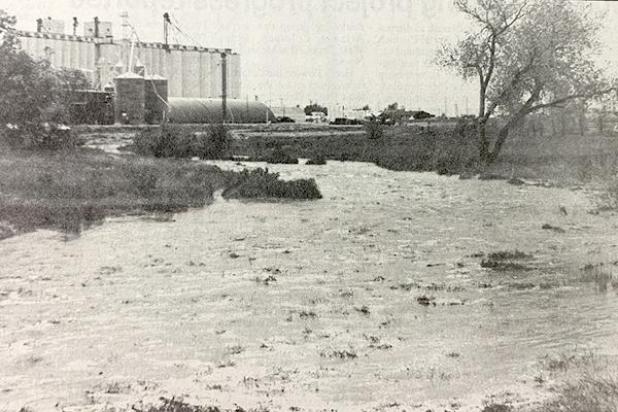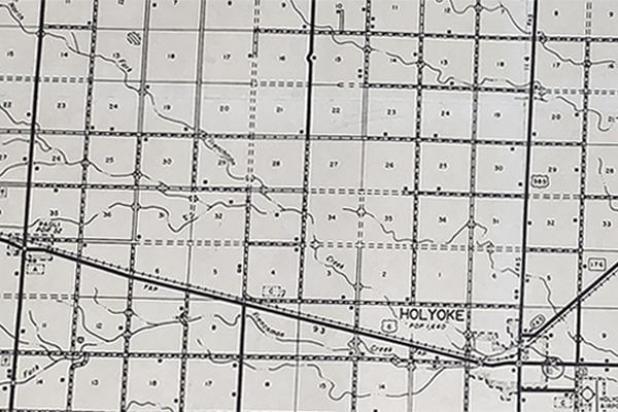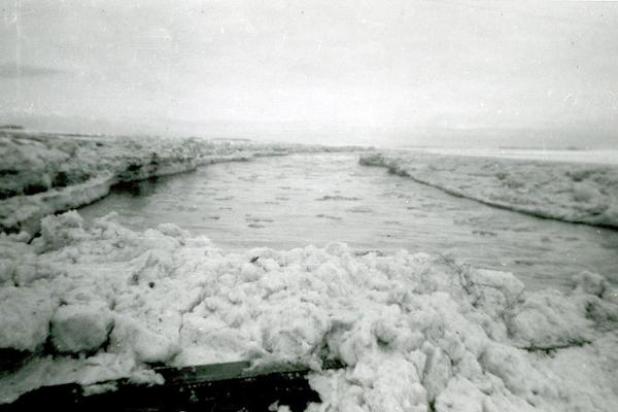
This photo from the June 8, 1995, edition of The Holyoke Enterprise shows the water level of the Frenchman Creek from the Highway 385 bridge on the north side of Holyoke on Sunday, June 4, 1995, after heavy rain in west Phillips County the previous night started the Frenchman flowing. — Enterprise File Photo

This 1976 map shows the north and south forks of the Frenchman Creek west of Holyoke. — Source: Phillips County Museum

The Frenchman Creek at Pleasant Valley Bridge is pictured March 10, 1960, after a heavy, wet snowstorm and a sudden melt got the creek flowing. — Source: Charley Triplette
Frenchman Creek an important part of area history
As many Phillips County residents know, whether or not the Frenchman Creek is running has been used as a gauge for moisture levels in the area for many years.
In his 1940 thesis, “A Brief Geohistoric Study of Phillips County, Colorado,” Gelort Carl Strehlow wrote that “Frenchman Creek, a tributary of the Republican River, rises in Logan County but crosses Phillips County from west to east, dividing it nearly in half.”
The Phillips County history book “Those Were the Days” notes that the Frenchman Creek does not become a flowing stream until it reaches Nebraska. Area residents know that this is the case unless there are storms that fill the creek with water.
Creek has history of running after heavy rains
The Frenchman Creek has played an active role in many significant storms over the years, sometimes overflowing its banks.
In his thesis, Strehlow wrote, “This creek is not a flowing stream until it crosses the state line. During times of heavy rains it may become a rushing torrent inundating rather large areas of farmland.”
The front page of the June 13, 1940, edition of the Enterprise sports the headline “Drouth broken by 4-inch rain” and notes that hail damaged crops and that high waters flooded low places. These waters “surged down the creek, overflowed the banks and inundated hundreds of acres of farmland.”
As reported in the June 22, 1967, edition of the Enterprise, “Frenchman Creek crested higher than for a number of years on Sunday, flooding a shed and corrals at the Dubbert place just north of Holyoke and washing out the two footbridges at the Holyoke golf course. The water receded early this week, then rose again yesterday, though not as high as on Sunday.”
Heavy rains in the Haxtun and Fleming area July 30, 1989, caused the creek to flood again.
Water headed east through Phillips County and flooded Paoli around 4:30 p.m. before moving into the creek areas of Holyoke near midnight.
The Enterprise reports that Sheriff Dick Potter said the water crested at about 1:45-2 a.m. at the Dubberts’ place north of Holyoke. In the article, Riley Dubbert said he had about 45 inches of water in his two lower buildings along the creek, and the last time he recalled having water in those buildings was more than 20 years earlier.
The June 8, 1995, edition of the Enterprise reports torrential rains that again caused the creek to flow. It notes that “just about every road that the Frenchman intersects was washed out” and people “gathered at bridges in the middle of the day Sunday to watch the water come in.
“Those who saw the spectacle were fascinated by the wall of tumbleweeds that preceded the water. According to one description, the cracking of the tumbleweeds sounded like a fire.”
The article also notes that some people could be seen rafting, tubing and canoeing in the creek, activities that turned dangerous when running water pinned an 11-year-old boy who was tubing at the golf course against a bridge and threatened to pull him into a drainage pipe.
The child was saved and taken to the hospital, but law enforcement at the time recommended that people stay out of the creek since the water was so dirty that all kinds of things could be under it.
The banks of the Frenchman overflowed again June 26, 1999. Pictures in the Enterprise show water rushing through the creek, and reports noted that roadways running perpendicular to the creek were covered by 6-8 inches of running water, which washed out some county roads.
Newspaper articles point to possibility of lake
Though the creek is dry, the April 21, 1922, edition of the Phillips County Herald recalls a report from 30 years earlier that notes, “Holyoke can have a good lake if the citizens will only take hold of the matter and make use of the water that now passes down the Frenchman. There is no question about there being plenty of water in the Frenchman to make a fine lake, and it would be a comparatively easy and inexpensive matter to control this water for that purpose.
“It will, of course, require some labor, but the expense would be very light indeed, when compared with the benefits to the town to be derived from such a body of water.”
As the subsequent edition, again recalling 30 years before, points out, “Some of our Holyoke citizens have decided to make investigations to ascertain the probable cost of using the water in the Frenchman to form a lake. This is a wise move, and if followed up by the citizens of the town as it should be, Holyoke will have a nice lake inside of three months.”
Different theories exist on origin of creek’s name
“Those Were the Days” points out that in Everette S. Sutton’s book “Sutton’s Southwest Nebraska,” Sutton claims the creek got its name from Joseph Beauvais, the son of Geminian Pierre (Jim Perry) Beauvais, who had a ranch and trading post, known as the Lone Star Trading Post, at the old California Crossing of the Platte River, 25 miles east of Julesburg on the Oregon Trail.
Joseph established a trapping line on what was then known as Whiteman’s Fork of the Republican River. The book notes that he had a dugout 4 miles from Frenchman Falls, later known as Frenchman’s Cave, and another at the mouth of Bovay (pronounced the same as Beauvais) Canyon, and in common usage became the Frenchman Creek or Frenchman River.
A March 2013 article in The Wauneta Breeze tells a different story of the origin of the Frenchman Creek’s name.
It reports that the creek was referred to as Whiteman’s Creek and Frenchman Creek in journals from military expeditions in the 1850s and 1860s. The newspaper account says the name is in reference to a French trapper who had a dugout along the creek between the present-day towns of Wauneta, Nebraska, and Hamlet, Nebraska.
Wauneta historian Chester Stock obtained information from the Nebraska Historical Society for the Breeze’s 75th anniversary edition, which was 50 years prior to the 2013 article.
The information states that early Nebraska maps don’t clearly indicate when the name was changed. It is called Frenchman’s Fork in Colton’s New Sectional Map of Nebraska 1866, but Colton’s 1873 map lists it as Whiteman’s Fork.
Guy Sims, an early resident of Wauneta and local historian, wrote a letter to Stock dated March 22, 1956. Sims wrote that there was no doubt that the white man referred to and the Frenchman were the same man, but Sims had not been able to find out who the man was, when he lived there or what became of him.
Sims went on to guess from the type of gun the man carried that he must have lived there sometime between 1825-1850.
“There was another old Frenchman in the valley down near Beverly,” wrote Sims. “I can’t spell his French name but it was pronounced Bovay ... Bovay was not the Frenchman the river was named for.”
According to “Historic Trail Maps of the Sterling 1˚ x 2˚ Quadrangle, Northeastern Colorado” by Glenn R. Scott, in 1860 a group of French Canadian buffalo hunters was massacred by Native Americans along a creek in eastern Colorado that was afterward named Frenchman Creek. It does not, however, point to this incident as having inspired the name of the creek.
Regardless of how exactly Frenchman Creek got its name, it is clear that the creek has affected the citizens of Phillips County in numerous ways and will continue to do so as a key part of the county’s geography and history.
